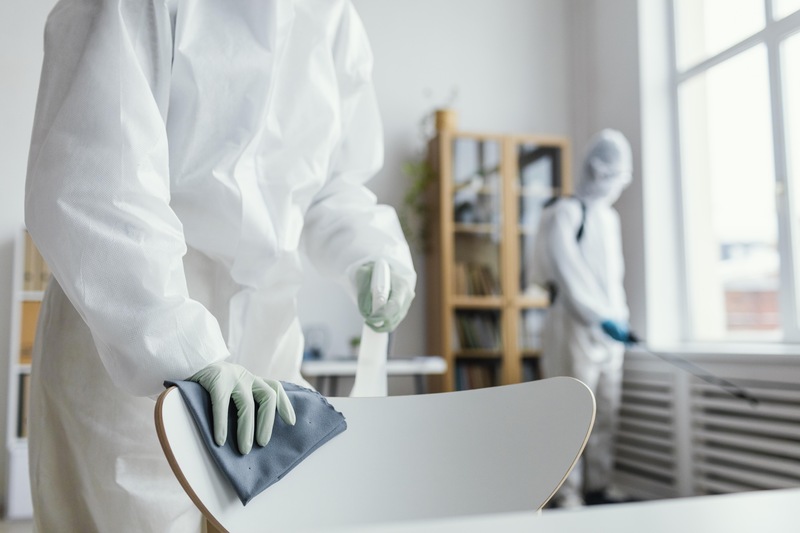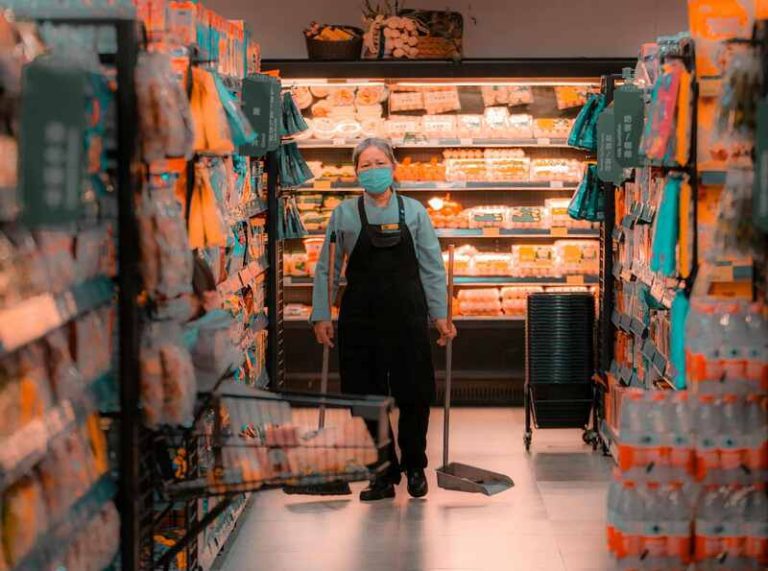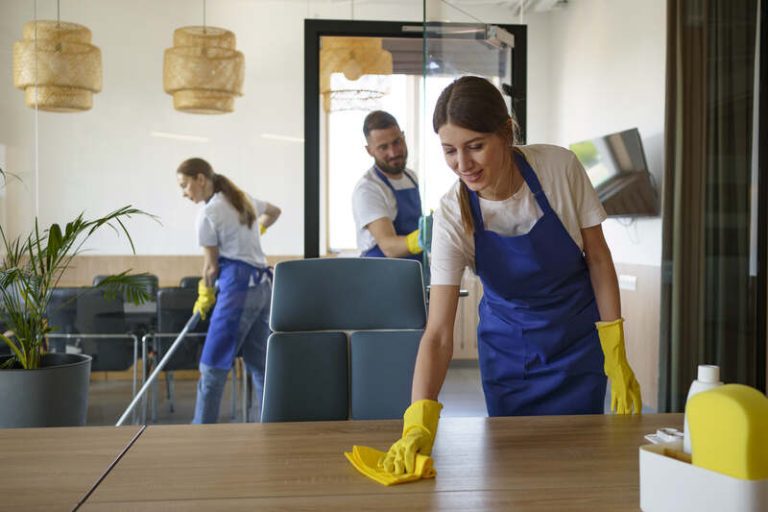Have you ever wondered if is cleaning the same as sanitizing? If you’re still confused, it’s time to know the difference between disinfecting and sanitizing.
This article will break down the difference between a disinfectant and a sanitiser, understanding how they work and the most commonly used products for each process. Discover when to disinfect and when to sanitise, as well as the right techniques for each.
Ultimately, by knowing the difference between cleaning and sanitizing, you will have a clear understanding of how to keep your space clean and safe.
Disinfecting Vs Sanitizing
Understanding the difference between a disinfectant and a sanitiser is crucial for maintaining a healthy environment. While both processes aim to reduce the presence of germs and bacteria, the methods and effectiveness vary significantly.
Disinfecting involves using chemicals to kill germs on surfaces and objects, typically with a stronger formulation than sanitizing. It targets a broader range of pathogens, including viruses and fungi, making it more effective in high-risk areas. On the other hand, sanitizing reduces the number of germs on a surface to a safe level but does not necessarily kill all of them.
When choosing between disinfecting and sanitizing, it’s essential to consider the specific needs of the environment. Areas with high touchpoints or those where infection control is critical may require regular disinfection. sanitizing, which is a quicker process, may be sufficient for low-risk settings.
What is Disinfecting?
Disinfecting is a process that involves the use of chemicals to kill germs, bacteria, and viruses present on surfaces. This method is especially crucial in environments where the risk of contamination is high, such as during the COVID-19 pandemic.
Effective disinfection not only helps in preventing the spread of infectious diseases but also ensures a safer and healthier living or working space. By eliminating harmful microorganisms, disinfecting surfaces significantly reduces the chances of contracting illnesses. If disinfection is not done correctly, there are potential risks involved. Inadequate practices may lead to microbial resistance, cross-contamination, or the survival of pathogens, posing a threat to public health and safety.
a. How Does Disinfecting Work?
Disinfecting works by applying specific disinfectant products that contain chemicals designed to kill bacteria and viruses on surfaces. Following proper instructions, such as contact time and dilution ratios, is crucial to ensure effective disinfection.
One common mechanism of action of disinfectants is the denaturation of proteins in microorganisms, disrupting their structure and function. This leads to the microorganism’s death or inability to reproduce. It’s important to understand that different disinfectants may target various aspects of the microorganism’s biology, affecting its ability to survive on surfaces.
The Centres for Disease Control and Prevention (CDC) provides guidelines for disinfection in various settings, emphasising the importance of using EPA-approved disinfectants and following the manufacturer’s instructions for proper application.
Best practices for effective disinfection include implementing a regular cleaning schedule, focusing on high-touch surfaces, and allowing sufficient contact time for the disinfectant to work its magic. By following these practices diligently, we can create safer environments and reduce the spread of harmful pathogens.
b. The Most Common Disinfectants
The most common disinfectants include products such as bleach, hydrogen peroxide, and quaternary ammonium compounds. These chemicals have proven efficacy in killing a wide range of harmful microorganisms.
Each type of disinfectant works differently and is effective against specific pathogens.
- Bleach, containing sodium hypochlorite, is excellent at killing bacteria and viruses, but it may not be as effective against certain fungi.
- Hydrogen peroxide is versatile and can tackle bacteria, viruses, fungi, and spores effectively.
- Quaternary ammonium compounds, often found in cleaning wipes and sprays, are particularly useful against enveloped viruses.
When selecting a disinfectant, consider factors like the type of surface, the specific pathogens you are targeting, and the contact time required for effective sanitization.
What is Sanitizing?
sanitizing is a process that aims to reduce the number of germs and bacteria on surfaces to a safe level, as determined by public health standards.
By eliminating harmful microorganisms, sanitizing plays a crucial role in promoting public health and maintaining hygiene standards. Whether it’s in healthcare facilities, food establishments, or homes, the practice of sanitizing surfaces can significantly reduce the risk of diseases spreading through touch or contact. Effective sanitizing not only protects individuals from illnesses but also fosters a clean and safe environment for everyone. Therefore, the importance of regular sanitisation cannot be understated in preventing the transmission of harmful pathogens and ensuring the well-being of communities.
a. How Does Sanitizing Work?
sanitizing works by reducing the number of bacteria and viruses on surfaces to a safe level, typically through the use of sanitizing agents or heat. This process helps lower the risk of infections and ensures a safer environment.
One of the key mechanisms of action of sanitizing agents is disrupting the cell membranes of microorganisms, ultimately leading to their destruction. By targeting the structural integrity of bacteria and viruses, these agents effectively neutralise and eliminate harmful pathogens.
Reducing microbial load on surfaces is crucial in various settings, including healthcare facilities, food preparation areas, and public spaces. High microbial loads can serve as reservoirs for pathogens, increasing the likelihood of cross-contamination and the spread of infectious diseases.
b. The Most Common Sanitizers?
Common sanitisers include alcohol-based solutions, quaternary ammonium compounds, and chlorine-based products. These sanitisers are effective in reducing germs on surfaces and are widely used in various settings.
Alcohol-based sanitisers are popular for their quick evaporation and broad-spectrum effectiveness against bacteria and viruses. Quaternary ammonium compounds, known for their residual antimicrobial effect, are commonly used in healthcare facilities. Chlorine-based sanitisers, such as bleach, are powerful against a wide range of pathogens but require proper dilution.
When choosing a sanitiser, consider the specific use case – for instance, alcohol-based sanitisers are convenient for quick disinfection on the go, while quaternary ammonium compounds are preferred for longer-lasting protection. It’s essential to follow manufacturer instructions for proper application and contact time.
The Differences Between Disinfecting Vs Sanitizing
The disparities between disinfecting vs sanitizing lie in their effectiveness, target microorganisms, contact time, and intended purpose. Understanding these differences is crucial for choosing the right approach to maintaining a hygienic environment.
Disinfecting involves using chemicals to kill a broader range of pathogens, including bacteria, viruses, and fungi, compared to sanitizing which focuses on reducing the number of specific types of bacteria.
While disinfection requires a longer contact time to ensure complete pathogen elimination, sanitisation is typically faster as it aims to lower the number of bacteria to safer levels.
Disinfecting is essential in high-risk areas such as hospitals and kitchens while sanitizing is more suitable for everyday items like utensils and surfaces.
a. Level of Effectiveness
Disinfecting is more effective than sanitizing in killing a broader spectrum of microorganisms, including viruses, bacteria, and fungi.
Regarding disinfecting, the goal is to completely eradicate pathogens, making the environment or surface safe for public health. This method is crucial in high-risk areas like hospitals, laboratories, and food processing facilities where a wide range of harmful microorganisms can pose serious threats.
On the other hand, sanitizing is commonly employed in everyday settings such as restaurants, schools, and homes, aiming to reduce the microbial load to prevent the spread of common germs without the need for complete elimination. This approach is practical for surfaces that come into contact with food or areas requiring quick cleaning to maintain hygiene.
b. Types of Microorganisms Targeted
Disinfecting targets a wide range of microorganisms, including bacteria, viruses, fungi, and protozoa. sanitizing primarily focuses on reducing bacterial populations, especially those that pose a health risk to humans.
Whilst disinfectants are designed to kill or inactivate a broader spectrum of microorganisms, sanitisers are mainly intended to reduce the number of bacteria to safe levels on surfaces. Bacteria are single-celled organisms that can be both harmful and beneficial, with some strains causing illnesses. Viruses, on the other hand, are even smaller entities that require a host to replicate and can cause diseases ranging from the common cold to more severe infections. Fungi, including moulds and yeasts, can grow in damp environments and may trigger allergies or infections.
Protozoa are microscopic eukaryotic organisms, some of which can be pathogenic to humans, causing diseases like malaria or giardiasis. Disinfecting agents play a crucial role in eliminating these varied microorganisms from surfaces, helping to prevent the spread of infectious diseases and maintaining a healthy environment.
c. Contact Time
Disinfectants typically require a longer contact time to effectively kill pathogens, ranging from several minutes to hours, depending on the product and the target microorganism whilst sanitisers have shorter contact times and are designed to quickly reduce microbial populations on surfaces.
In the realm of disinfection and sanitisation, contact time plays a crucial role in ensuring the efficacy of these products. For instance, products like bleach-based disinfectants might need up to 10 minutes of contact time to eliminate harmful bacteria and viruses effectively. On the other hand, alcohol-based sanitisers are fast-acting and can achieve their purpose in just a matter of seconds to a minute. Understanding the specific requirements of each product is essential for proper usage and desired outcomes.
d. Purpose
The primary purpose of disinfecting is to kill or deactivate a wide spectrum of pathogens present on surfaces, reducing the risk of infections and diseases.
Regarding disinfecting, the goal is to tackle harmful bacteria, viruses, and fungi that can pose serious health risks. By using strong chemical agents or UV light, disinfection ensures a thorough elimination of these pathogens. This method is crucial in high-risk environments like hospitals, laboratories, and food processing facilities where preventing the spread of infectious diseases is paramount.
When Should You Disinfect?
Disinfecting surfaces should be prioritised in high-traffic areas, healthcare facilities, and environments where there is a higher risk of contamination, such as during disease outbreaks like COVID-19.
Regular disinfection plays a critical role in preventing the spread of harmful pathogens, bacteria, and viruses. In settings like hospitals and clinics, disinfection is not just essential but a mandatory practice to ensure patient safety and control nosocomial infections.
For shared spaces like gyms, schools, and public transport, frequent disinfection is recommended to safeguard public health. During infectious disease outbreaks, ramping up disinfection efforts becomes even more crucial to break the transmission chain and protect communities.
When Should You Sanitize?
Sanitizing surfaces is advisable in environments where maintaining public health and hygiene is essential. Common areas, food preparation spaces, and frequently touched surfaces should be regularly sanitised to reduce the risk of germ transmission.
Especially in high-traffic locations such as schools, hospitals, and office buildings, proper sanitisation is crucial to prevent the spread of illnesses.
Regularly sanitizing surfaces like doorknobs, light switches, and countertops can significantly decrease the number of viable pathogens present, creating a healthier environment for everyone.
It’s recommended to incorporate sanitisation routines into daily hygiene regimens, using disinfectants approved by health authorities and following guidelines for effective cleaning practices.
How to Properly Disinfect and Sanitize?
Properly disinfecting and sanitizing surfaces requires selecting the right products, following manufacturer instructions, and employing effective application techniques. Using appropriate protective gear, such as gloves, is essential when working with chemicals like bleach.
Product selection plays a crucial role in the disinfection process. Choose disinfectants that are EPA-approved and effective against the specific pathogens you are targeting. Read the labels carefully to ensure the product is suitable for the surface you intend to clean.
Adherence to instructions is key; follow dilution ratios, contact times, and safety precautions outlined on the product packaging. When applying the disinfectant, make sure to cover all areas thoroughly, including high-touch surfaces and frequently used objects.
Effective application methods involve using a clean cloth or disposable wipes to apply the solution, ensuring even coverage. Allow sufficient dwell time for the disinfectant to work its magic before wiping or rinsing off.
a. Choosing the Right Product
Selecting the appropriate disinfectant or sanitiser is crucial for effective pathogen control. Consider factors such as the type of surface, the target microorganisms, and any specific requirements, such as non-toxic formulations or compatibility with certain materials.
When choosing a disinfectant or sanitiser, it’s essential to take into account the surface material. Porous surfaces like fabric may require different products compared to hard, non-porous surfaces like glass or metal.
The range of microorganisms you want to target also plays a significant role in product selection. Some disinfectants are formulated for specific types of bacteria, viruses, or fungi, so knowing the intended use can guide your choice.
Considering specific requirements, such as eco-friendly options or products safe for use around children or pets, is paramount in ensuring effective and safe cleaning.
b. Following Instructions
Adhering to manufacturer instructions and CDC guidelines is essential for the proper use of disinfectants and sanitisers. Failure to follow recommended procedures can lead to ineffective pathogen control and potential health risks.
Proper disinfection and sanitisation protocols are critical in various settings, from residential homes to healthcare facilities. Ensuring a thorough understanding of the instructions provided by the manufacturer can significantly impact the outcome. The Centers for Disease Control and Prevention (CDC) emphasises the importance of following proper procedures to eliminate harmful pathogens and reduce the risk of infections.
- One of the key steps recommended by health authorities involves using the appropriate concentration of the disinfectant according to the label.
- Allowing sufficient contact time for the disinfectant to work effectively is crucial in achieving optimal results.
Remember that compliance with product guidelines is essential for maximising the efficacy of disinfectants and sanitisers.
c. Proper Application Techniques
Applying disinfectants and sanitisers correctly is essential for thorough pathogen elimination. Ensure complete coverage of surfaces, adequate contact time, and proper ventilation during the application process to maximise effectiveness.
To achieve optimal results, it is crucial that the chosen disinfectant is appropriate for the specific pathogens being targeted. Different pathogens may require different formulations for effective elimination. Always follow manufacturer guidelines for dilution ratios and application procedures to ensure maximum efficacy.
Remember to inspect surfaces for visible dirt and debris before applying the disinfectant. Cleaning surfaces beforehand removes barriers that could hinder the disinfectant’s effectiveness. After application, allow sufficient contact time for the disinfectant to work its magic; rushing this step may compromise the overall efficacy of the process.
Conclusion
Understanding the nuances between disinfecting and sanitizing is paramount for effective cleaning practices. By selecting the right products, following proper instructions, and applying suitable techniques, individuals can ensure the maintenance of a safe and hygienic environment.
In today’s world, achieving a truly clean environment is more crucial than ever for businesses. It goes beyond appearances, ensuring safety and well-being for both customers and employees. TEKA Cleaning offers specialised disinfection spray cleaning services, partnering with industry leader Karcher, to provide comprehensive, efficient cleaning solutions tailored to your business needs.
Our service is designed not just to clean but to disinfect, reaching every corner and surface, reducing the spread of pathogens, and helping your business meet and exceed health and safety standards. This proactive approach is essential for maintaining a healthy, productive workspace and ensuring business continuity.
Don’t let the cleanliness of your workspace be an afterthought. Elevate your standards with TEKA Cleaning. Book our specialised disinfection spray cleaning service now or give us a call on 01233 751 544. Protect your business, your employees, and your customers with TEKA Cleaning.
Read also:










